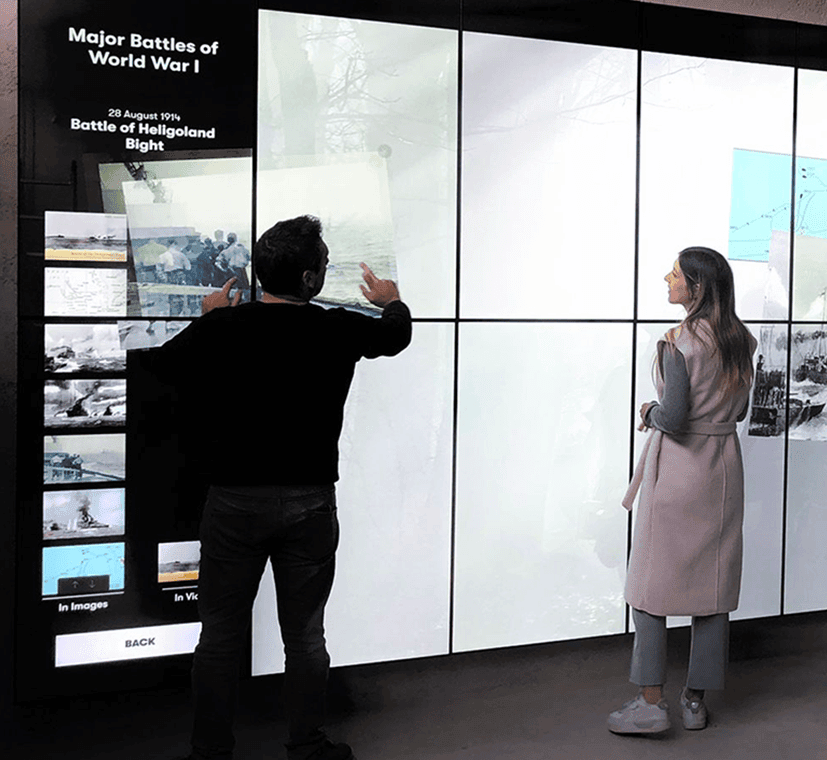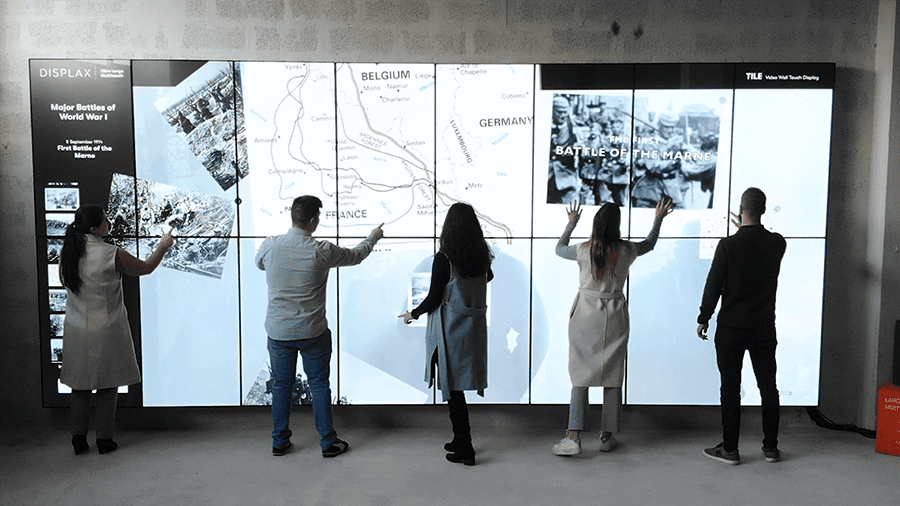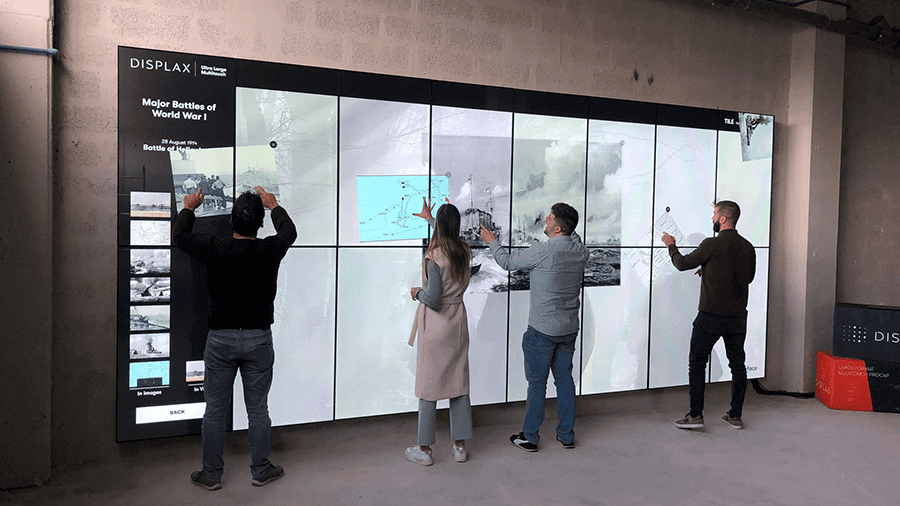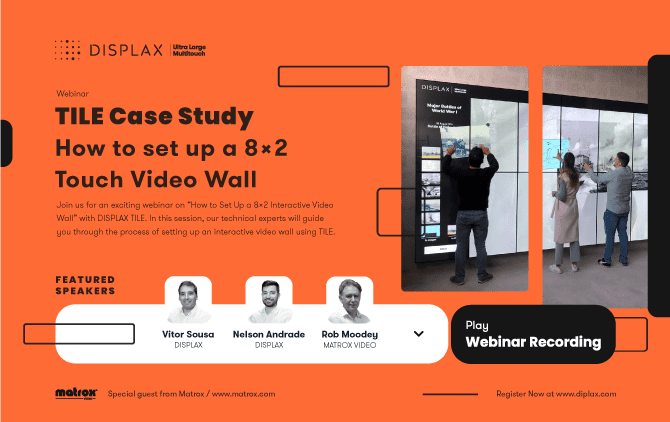CASE STUDY
8×2 Interactive Video Wall Installed in One Day – Museum Project
Project snapshot
Location & Industry:
Portugal / Museum
Project:
8×2 TILE interactive video wall
Installed:
1 day (site-ready & live)
Key tech:
TILE PCAP displays, plug-and-play architecture, multi-OS support.
CASE STUDY
8×2 Interactive Video Wall Installed in One Day – Museum Project
Project snapshot
Location & Industry:
Portugal / Museum
Project:
8×2 TILE interactive video wall
Installed:
1 day (site-ready & live)
Key tech:
TILE PCAP displays, plug-and-play architecture, multi-OS support.
Project overview
An 8×2 Interactive Centerpiece for a Modern Museum
The museum commissioned a large, interactive centerpiece to enrich visitor engagement. The brief required a highly responsive multi-touch video wall, able to run in a bright public space, support multiple simultaneous users, and be installed and operational quickly with minimal downtime. DISPLAX delivered a modular 8×2 TILE Pro solution that met these needs and went live the same day.
Project overview
An 8×2 Interactive Centerpiece for a Modern Museum
The museum commissioned a large, interactive centerpiece to enrich visitor engagement. The brief required a highly responsive multi-touch video wall, able to run in a bright public space, support multiple simultaneous users, and be installed and operational quickly with minimal downtime. DISPLAX delivered a modular 8×2 TILE Pro solution that met these needs and went live the same day.
The challenge
Delivering a large-scale interactive video wall in a public museum space
Designing and installing a video wall in a public museum is never just about putting big screens together. The installation must balance scale, durability, usability, and practicality — all under the pressure of limited setup time and constant public exposure.
Key requirements included:
Bright ambient light and reflections:
The wall needed to perform flawlessly in open, well-lit spaces where daylight and artificial lighting can wash out displays or interfere with older, camera-based touch technologies.Large scale + seamless alignment:
With 16 displays working together, uniform color, brightness, and bezel alignment were critical to deliver a visually consistent canvas without distracting gaps or mismatches.Multi-user, high-traffic interaction:
Museums attract groups of families, students, and visitors. The wall had to support dozens of simultaneous touches with low latency and precise accuracy, without “ghost touches” or lag.Fast and simple installation:
Public projects run on tight schedules. The museum needed a system that could be assembled quickly, without handling heavy sheets of custom glass or wiring dozens of extra hardware components.Robustness and vandal resistance:
Public-facing installations are exposed to constant, sometimes rough usage. The wall had to be vandal-proof, reliable 24/7, and easy to maintain, ensuring staff could keep it running without specialized technical skills.
In short, the challenge was to deliver a massive interactive canvas that looks seamless, works flawlessly in any light, survives high traffic, and is practical to install and maintain, without requiring hundreds of fragile parts or complex integrations.
The challenge
Delivering a large-scale interactive video wall in a public museum space
Designing and installing a video wall in a public museum is never just about putting big screens together. The installation must balance scale, durability, usability, and practicality — all under the pressure of limited setup time and constant public exposure.
Key requirements included:
Bright ambient light and reflections:
The wall needed to perform flawlessly in open, well-lit spaces where daylight and artificial lighting can wash out displays or interfere with older, camera-based touch technologies.Large scale + seamless alignment:
With 16 displays working together, uniform color, brightness, and bezel alignment were critical to deliver a visually consistent canvas without distracting gaps or mismatches.Multi-user, high-traffic interaction:
Museums attract groups of families, students, and visitors. The wall had to support dozens of simultaneous touches with low latency and precise accuracy, without “ghost touches” or lag.Fast and simple installation:
Public projects run on tight schedules. The museum needed a system that could be assembled quickly, without handling heavy sheets of custom glass or wiring dozens of extra hardware components.Robustness and vandal resistance:
Public-facing installations are exposed to constant, sometimes rough usage. The wall had to be vandal-proof, reliable 24/7, and easy to maintain, ensuring staff could keep it running without specialized technical skills.
In short, the challenge was to deliver a massive interactive canvas that looks seamless, works flawlessly in any light, survives high traffic, and is practical to install and maintain, without requiring hundreds of fragile parts or complex integrations.
The solution
How DISPLAX handled it
Design & planning
Pre-installation engineering: tiled layout drawings, structural mounts, cable & power routing, content mapping, and safety checks were completed before arrival. This reduced on-site decisions and shortened the install window.
Pre-staged tiles and accessories in the truck: modules were tested and labeled for fast swap/stack during installation.
Modular TILE hardware
TILE’s modular approach enables precise mechanical alignment and simplified electrical / signal daisy-chain connections. This modularity is essential in large arrays to reduce complexity and speed installation.
High optical clarity & ambient performance
PCAP bonding and optical design preserve display brightness and clarity: critical in bright museum spaces so content stays vivid and touch remains accurate. (PCAP also minimizes internal reflections compared with non-bonded alternatives.)
Multi-touch reliability & low latency
TILE’s PCAP implementation delivers consistent, low-latency multi-touch capability so multiple visitors can interact simultaneously without performance issues. Firmware tuning and testing were performed before handover.
Calibration & colour / brightness uniformity
After mechanical alignment, we ran calibration routines to equalize brightness and color across all panels, using built-in tools and test content to ensure uniformity. Ongoing calibration is part of the recommended maintenance plan for large arrays.
Power, signal, and cabling best practice
Power distribution was planned to avoid bottlenecks and to provide clean switching and protection. Signal routing minimized latencies and ensured smooth content playback across the entire matrix. Pre-wired cable looms and discrete labeling saved time on site.
Simple handover & staff training
On completion we ran user acceptance tests with museum staff, delivered a short training session, and provided documentation so the team could operate and maintain the wall independently.
“This project proves how TILE makes large-scale interactive video walls fast to deploy and easy to run. From delivery to operation in a single day, without compromising performance or reliability.”
Vítor Sousa, Support Director @ DISPLAX
The solution
How DISPLAX handled it
Design & planning
Pre-installation engineering: tiled layout drawings, structural mounts, cable & power routing, content mapping, and safety checks were completed before arrival. This reduced on-site decisions and shortened the install window.
Pre-staged tiles and accessories in the truck: modules were tested and labeled for fast swap/stack during installation.
Modular TILE hardware
TILE’s modular approach enables precise mechanical alignment and simplified electrical / signal daisy-chain connections. This modularity is essential in large arrays to reduce complexity and speed installation.
High optical clarity & ambient performance
PCAP bonding and optical design preserve display brightness and clarity: critical in bright museum spaces so content stays vivid and touch remains accurate. (PCAP also minimizes internal reflections compared with non-bonded alternatives.)
Multi-touch reliability & low latency
TILE’s PCAP implementation delivers consistent, low-latency multi-touch capability so multiple visitors can interact simultaneously without performance issues. Firmware tuning and testing were performed before handover.
Calibration & colour / brightness uniformity
After mechanical alignment, we ran calibration routines to equalize brightness and color across all panels, using built-in tools and test content to ensure uniformity. Ongoing calibration is part of the recommended maintenance plan for large arrays.
Power, signal, and cabling best practice
Power distribution was planned to avoid bottlenecks and to provide clean switching and protection. Signal routing minimized latencies and ensured smooth content playback across the entire matrix. Pre-wired cable looms and discrete labeling saved time on site.
Simple handover & staff training
On completion we ran user acceptance tests with museum staff, delivered a short training session, and provided documentation so the team could operate and maintain the wall independently.
“This project proves how TILE makes large-scale interactive video walls fast to deploy and easy to run. From delivery to operation in a single day, without compromising performance or reliability.”
Vítor Sousa, Support Director @ DISPLAX
Webinar recording
How to Set Up an 8x2 Touch Video Wall
How to Set Up an 8x2 Touch Video Wall
Key technical steps, best practices and lessons from a full-scale installation
Key technical steps, best practices and lessons from a full-scale installation
In this on-demand webinar, our technical experts walk you through how we designed, assembled, and calibrated the museum’s 8×2 TILE Pro video wall. Gain insights into everything from input configurations and daisy chaining to touch calibration and display performance under bright ambient lighting.
Webinar recording
How to Set Up an 8x2 Touch Video Wall
How to Set Up an 8x2 Touch Video Wall
Key technical steps, best practices and lessons from a full-scale installation
Key technical steps, best practices and lessons from a full-scale installation
In this on-demand webinar, our technical experts walk you through how we designed, assembled, and calibrated the museum’s 8×2 TILE Pro video wall. Gain insights into everything from input configurations and daisy chaining to touch calibration and display performance under bright ambient lighting.














